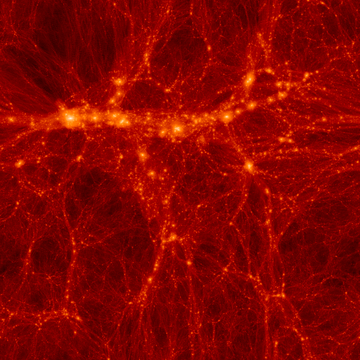Cosmography and Large-Scale Structure
Research Topics
Cosmography, the cosmic web and dwarf galaxies in the local Universe
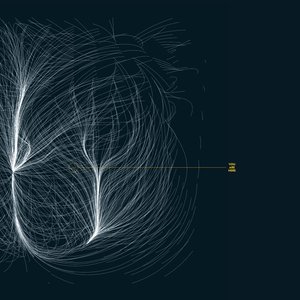
The peculiar velocities of galaxies near the Local Group.
Credit: Libeskind & Tully, (C) Scientific American.In the vastness of outer space, gravity is the only force at work: it keeps the moon in orbit around the Earth, the planets in orbit around the Sun, our Sun tied to the Milky Way and our Galaxy bound to the Local Group, an ensemble of a dozen or so dwarf galaxies that define our cosmic tribe. Gravity determines the motion of the Local Group through intergalactic space, as it is pulled by large neighbouring galaxies like the radio blasting Centaurus A or the giant elliptical galaxy M87. But our cosmic coordinates do not stop with our association to the Local Group. The Local Group is small association floating towards the Virgo cluster, a bundle of around 2000 galaxies that swarm randomly around a common focus. Until recently the Virgo cluster was believed to be the frontier of what we could define as "home". Beyond it lay a vast universe to which we could lay no claim. Recent studies, that focus on the motions (instead of the positions) of galaxies reveal the Virgo cluster to be a relatively small appendage to larger consortium, recently named as the Laniakea supercluster. Laniakea itself is probably affiliated with the Shapley super cluster.
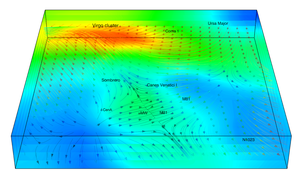
The Local Universe is shown here as a section of the super galactic plane. Both the density (color) and the corresponding velocity field (flow lines) are Wiener Filter reconstructions obtained from the CosmicFlow-2 radial peculiar velocity catalogue, which recover the observed structure in local cosmic neighborhood remarkably well.
Credit: Libeskind et al. 2015Charting the universe is a difficult task, one that requires both precision instruments and advanced techniques. Furthermore, once galaxies have been photographed and their positions mapped, their interconnectedness needs to be established. In this collaboration we strive to advance techniques to tackle both of these challenges. On one hand we apply for time on facilities such as the Hubble Space Telescope in order to acquire images of faint dwarf galaxies. On the other we analyse their spatial distribution and try to asses how the local universe was created - how the dwarf galaxies in the Local Group were formed and what the role of the cosmic web is in shaping our environment. We develop techniques to quantify the cosmic web and relate it to our cosmic coordinates.
Lead Investigators: Noam Libeskind, Stefan Gottloeber, Matthias Steinmetz, Simon Pfeifer, Chaimonkol Duanchuan (allAIP), Aurelien Valade (Marseilles), Peng Wang (Shanghai), Elmo Tempel (Tartu), David Benisty (Cambridge), Yehuda Hoffman (Jerusalem), Brent Tully (Hawaii), Daniel Pomarede (Saclay).
Constrained simulations of the local universe - CLUES collaboration
Cosmological simulations have become the standard tool to test theories of structure growth and galaxy formation in the non-linear regime. Traditionally these tests are carried out in a statistical sense. Namely, a cosmological model is chosen and a power spectrum of fluctuations is used to construct a (Gaussian) random realisation of the primordial density field. The growth of these perturbations is evolved numerically from high redshift until today.
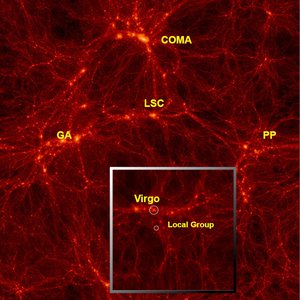
Dark matter distribution in our Local Universe in two different simulations indicating prominent structures surrounding us. Shown is a box with 160 Mpc/h side length (big picture) and with 64 Mpc/h side length (inset panel).
Credit: S. Gottlöber, G. Yepes, A. Klypin, A. Khalatyan; CLUES CollaborationWhile hugely successful, the approach is by construction statistical and thus runs into trouble when specific cosmological structures are sought. For example, cosmography of the local universe has revealed a very well defined “landscape” with features such as the Virgo and Coma cluster, the great attractor, the great wall, the local void and the Shapley super cluster. Not only are there important cosmographic features like the ones just mentioned, but our dynamical environment — the dipole of the cosmic microwave background and our bulk flow - also demand an explanation. One way of addressing this is to constrain the initial conditions in a way which forces the simulation to converge towards a pre-determined input (namely todays local density and velocity field). This is achieved by a technique known as “constrained simulations”. The CLUES collaboration, one of the leaders in the field, aims at producing such constrained initial conditions for hydrodynamic simulation.
To improve the generation of constrained initial conditions for realistic numerical simulations of the local environment, we will complement observed radial peculiar velocity constraints of the Cosmic-Flows survey with density constraints, derived from galaxy redshift surveys. This is expected to increase the masses of nearby galaxy clusters so that they match observational data. We anticipate that this will improve our understanding of the formation of the Local Group and the structure of the local environment, the "Holy Grail" in near field cosmology.
Lead investigators: Noam Libeskind (AIP), Stefan Gottloeber (AIP), Chaimongkol Duanchaun (AIP), David Benisty (Cambridge), Elmo Tempel (Tartu), Arianna Di Cintio (Tenerife), Matthias Steinmetz (AIP), Peng Wang (shanghai), Gustavo Yepes (Madrid), Yehuda Hoffman (Jerusalem), Brent Tully (Hawaii), Chris Brook (Tenerife)
High-resolution Environmental Simulations of The Immediate Area - The HESTIA project
We are currently producing high-resolution magneto-hydrodynamics simulations of the Milky Way and Andromeda galaxy embedded in their local cosmic environment within the context of the HESTIA project. This project employs the Auriga galaxy formation model of the Arepo code, which accounts for a large number of physical processes "sub-grid” such as black hole growth, star formation and various forms of feedback. The project has been awarded 30 million computing hours on the SUPERMUC machine at LRZ/Garching. We will produce nested suites of constrained simulations with increasing resolution to understand the effects of our cosmic environment on the formation of the Local Group: starting with some 500 low-resolution simulations, we select the best systems for resimulation at progressively higher resolution, in order to arrive at the golden five simulations at very-high resolution (Mcell ∼ 105 M⊙).
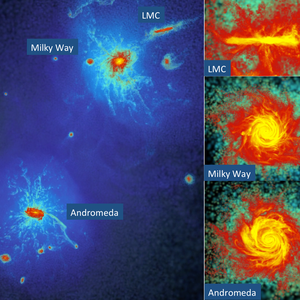
The gas distribution of a simulated the Local Group. The Hestia simulation project will simulate the same environment, but include more realistic physics and use a higher resolution.
Credit: CLUES CollaborationThis project enables us to address many scientific question ranging from galactic (chemo-)dynamics, to properties of Local-group dwarf satellites, to the growth of the Galactic magnetic field and how it affects the propagation of ultra high-energy cosmic rays. Comparison to the sample of 30 simulated Auriga galaxies, which have been selected to form in isolation, allows addressing the effect of the Andromeda galaxy and the Local-group environment on properties of the simulated Milky Way galaxy and its satellite system. This project is expected to provide am excellent data base for comparison to current and future observations (Gaia, RAVE, APOGEE, 4MOST, ...).
Lead investigators (in alphabetic order): Tobias Buck (AIP), Christina Chiapinni (AIP), Arianna Di Cintio (Tenerife), Stefan Gottloeber (AIP), Rob Grand (Liverpool), Yehuda Hoffman (Jerusalem), Alexander Knebe (UAM), Noam Libeskind (PI, AIP), Ivan Minchev (AIP), Rüdiger Pakmor (MPA), Christoph Pfrommer (AIP), Martin Sparre (AIP), Volker Springel (MPA), Matthias Steinmetz (AIP), Elmo Tempel (Tartu), Mark Vogelsberger (MIT), Peng Wang (Shanghai), Gustavo Yepes (UAM)
